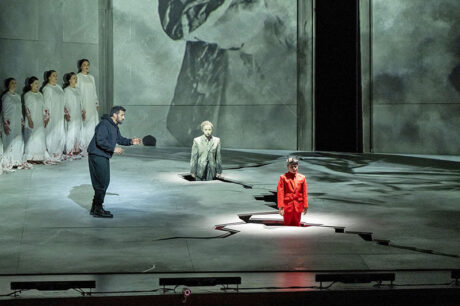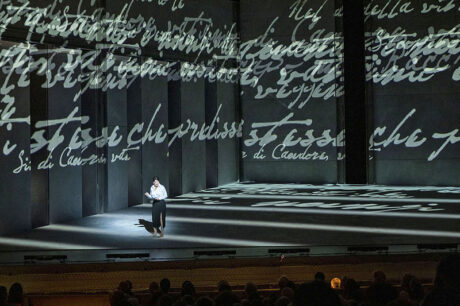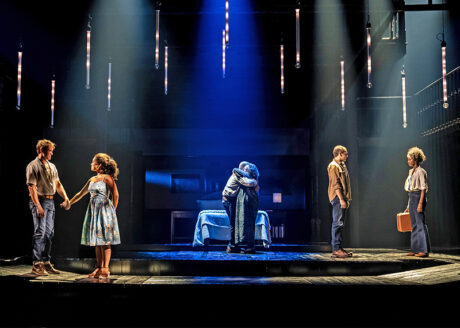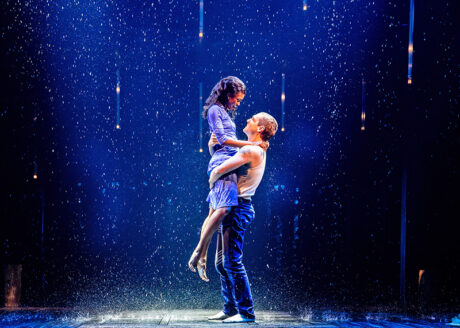
Macbeth at New Zealand Opera
The New Zealand Opera’s recent acclaimed production of Giuseppe Verdi’s Macbeth unleashed a classic and grisly narrative of power, politics, corruption, murder, and authoritarianism… that is every bit as pertinent today as when William Shakespeare penned the original play, circa 1606. The performance opened at the Aotea Centre in Auckland, then travelled to the St James Theatre in Wellington and the Isaac Royal Theatre in Christchurch impressing critics and thrilling audiences.
Lighting Designer Matt Marshall was delighted to be part of the creative team delivering this impressive production. It was his first creative collaboration with British Director / Designer and Video Artist Netia Jones who designed set, costumes, and video as well as directing the work. Projected images played a prominent role in the dramaturgy, beamed onto three imposing scenic walls making up the set. As the only other technical creative in this structure, plenty of expectation was on Marshall to deliver a smart and dramatic lighting design to suit the visceral power of the piece.
The general challenge in lighting this production was accentuating all the nuance and intrigue involved as Francesco Maria Piave’s libretto was unfolded, capturing the intricacy and narcissism of the characters and the cynicism of their actions. There had to be a constant and complete balance between the two visual media—light and moving image—to enhance the compelling storytelling, and Marshall enjoyed working with Jones enormously to create this fluidity and sense of visual spectacle.

With video projections so fundamental to the action and aesthetics, this informed the way he lit the stage and cast. It was his needing a specific and refined back light to give depth and three-dimensionality which led Marshall to Robe T1 PC moving lights to make the characters pop out but not affect the impact of the images. It was the first opera that he has lit using T1 PC fixtures which provided soft back lighting to delineate the cast and evoke a sense of separation between them and the large video projections across the set.
Marshall—who works internationally and prolifically on cutting edge opera and contemporary dance productions—first saw the Robe T1 fixtures at a demo by Australian distributor Jands and was struck by their silence in addition to the quality of light. The production’s visual style was very Noir with multiple greyscales, monochromacy, and sharp contrasts, so he needed a crisp, cold white to complement and contrast with this; for which the seven T1 PCs were a perfect solution. Having previously used T1 and T2 Profiles on shows for the Western Australian Ballet in 2021, he knew that light output was excellent and that the products were ideal for this environment, but it was the quietness that really blew him away. It’s also something that is essential for opera, as everyone involved in this genre of performance—from the orchestra and conductor to all the artists—is acutely conscious of ambient noise levels. Other features like the accurate shuttering system and super-smooth dimming were also useful, especially when confining light to specific areas and preventing spill onto the set.
The set was essentially a giant angled box wrapping an almost bare stage, so the trick was penetrating this space and using it properly and intelligently to relate the story. Fixture placement was absolutely critical in each venue and lights had to be rigged on drop bars and other rigging infrastructure to get them spot-on, as no luminaire could be below the 10-meter projector pathway.
Marshall loved thinking out of the box and taking a different approach to lighting such a classic opera as much as he enjoyed utilizing the T1 PCs which he reckons added a sense of clean white slickness to the grungy downbeat atmosphere of the proverbial ‘Scottish play.’ The moving lights were supplied to the production by Wellington-based Grouse Lighting.
Learn more about Robe lighting at www.robe.cz.

The Notebook Brings the Classic Novel to the Stage
Based on the iconic New York Times bestselling novel of the same title by Nicholas Sparks, The Notebook is a new musical that brings the beloved romance to the stage. The musical—which recently opened at the Chicago Shakespeare Theater—was scored by singer-songwriter Ingrid Michaelson, scripted by Bekah Brunstetter, choreographed by Katie Spelman and directed by Michael Greif and Schele Williams. In order to enhance the story’s flashback-based plot that spans multiple timelines, the production required a flexible and powerful lighting design that could contain multiple looks on stage at once. To ensure an emotionally captivating and visually immersive stage experience for the debut of The Notebook, Lighting Designer Ben Stanton utilized Martin MAC Ultra Performance and MAC Ultra Wash fixtures provided by Christie Lites.
“For The Notebook, malleability was a really important component of the lighting design,” said Stanton. “I needed to have the lighting be able to shift tone and realities really quickly—lighting that could hold the present and the past onstage at the same time. We also needed a lot of flexibility with the lighting in order to be able to carve out little scenes within a larger context. The lighting needed to be powerful enough to not only activate the set—which was painted all black—but also cut through it.”
Martin MAC Ultra Performance and MAC Ultra Wash are two new fixtures that represent Martin’s largest engineering initiative in the past decade. Featuring benchmark output across the zoom range, a true next generation framing system, higher definition optics and astoundingly low noise levels, the MAC Ultra fixtures helped Stanton provide powerful and stunning visual effects for the production without negatively impacting quiet moments with noisy fixtures. In addition to the MAC Ultra fixtures, Stanton utilized Martin MAC Encore Performance fixtures to provide key lighting.

“The MAC Ultra Wash and Performance are two of the most powerful lights I’ve ever used in a theater setting,” explains Stanton. “In the past, designers had to accept that if you wanted a really powerful moving light, it was going to be a loud fixture. It’s incredible how quiet the MAC Ultras are. The Notebook is a subtle, beautiful musical, and I never had an issue with the MAC Ultra fixtures being too loud.”
Originally slated for 2020, the original timeline of The Notebook was postponed due to Covid-19 restrictions. During the delays, Martin introduced the new Martin MAC Ultra fixtures, which turned out to be a boon for the production. Stanton noted his long-standing relationship with Christie Lites as a contributing factor to securing the new Martin fixtures for the production, and with hopes of staging The Notebook on Broadway in the near future, noted his continued reliance on them in the future. “I’ve worked with Christie Lites for decades,” said Stanton. “I’ve always felt very supported by them and have come to rely on Martin gear on a lot of my shows. For The Notebook, the MAC Ultra was a game changer in terms of quality, reliability, efficiency and fan noise. The power and sensitivity of the fixture had a big impact on the final design. We were all very pleased.”
Find out more about the Martin fixtures at www.martin.com.


